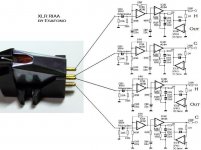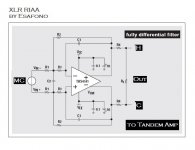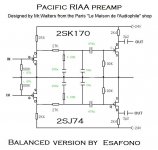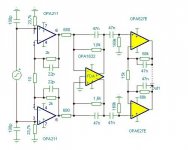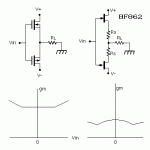indeed ...
that is a lot of components to match and there are likely more elegant and higher performance approaches available.
but, who am i to say. 🙂
give it a go and let us know how it works out ...
best regards,
mlloyd1
that is a lot of components to match and there are likely more elegant and higher performance approaches available.
but, who am i to say. 🙂
give it a go and let us know how it works out ...
best regards,
mlloyd1
Running the cartridge balance is a very good idea (says the guy who runs his cartridge balanced). These are just not good implementations. The second one will have degraded noise performance.
There are (to my knowledge) two good ways to do it. One is to build a fully differential phono input, the other is to use a transformer at the input and run the primary balanced. The secondary can then drive the input of a conventional single-ended stage. You get 99% of the balanced advantage that way.
There are (to my knowledge) two good ways to do it. One is to build a fully differential phono input, the other is to use a transformer at the input and run the primary balanced. The secondary can then drive the input of a conventional single-ended stage. You get 99% of the balanced advantage that way.
thanks <SY>
do you have a schematic of fully differential one?
http://www.esafono.it/diff.jpg
this is just a project with OPA1632
do you have a schematic of fully differential one?
http://www.esafono.it/diff.jpg
this is just a project with OPA1632
Only with tubes, but I'll bet there's a transistorized one around the forum somewhere. The "search" function is your friend.
Here's an example of a tube one:
http://www.vacuumstate.com/schematics/rtp3c_s.gif
edit: The one you linked to looks much better.
edit edit: "Better" than the first one, not better than the Vacuum State one; sorry to be ambiguous.
Here's an example of a tube one:
http://www.vacuumstate.com/schematics/rtp3c_s.gif
edit: The one you linked to looks much better.
edit edit: "Better" than the first one, not better than the Vacuum State one; sorry to be ambiguous.
thesis: balancing improves
to see if the hypothesis is correct
I did a simple test that anyone can repeat at home
steps:
listen a preferred song only from one channel
for example the right channel
turn off everything
connect the left channel wire on cartridge instead of ground wire
and connect the negative pole of right loudspeaker
on left output of the amplifier
push on everything
hear the same song...
I believe the difference is very significant :
the sound is more dynamic
treble are more crystalline
the noise is reduced!
to see if the hypothesis is correct
I did a simple test that anyone can repeat at home
steps:
listen a preferred song only from one channel
for example the right channel
turn off everything
connect the left channel wire on cartridge instead of ground wire
and connect the negative pole of right loudspeaker
on left output of the amplifier
push on everything
hear the same song...
I believe the difference is very significant :
the sound is more dynamic
treble are more crystalline
the noise is reduced!
Attachments
Lovely picture 🙂
It seems you are listening to the entire chain balanced now, not just the phono. Difficult to know how much of the improvement is due to the phono stage but interesting all the same. No hum?
It seems you are listening to the entire chain balanced now, not just the phono. Difficult to know how much of the improvement is due to the phono stage but interesting all the same. No hum?
an uneconomic improvement
certainly difficult to discriminate between contributions...
now I have an economic turntable - kenwood
with economic MM head and shielded container (on the ground)
no hum
test you also
it's easy with great satisfaction
But attention
must buy a second complete electronics once heard this quality!
(or build a fully differential one)
certainly difficult to discriminate between contributions...
now I have an economic turntable - kenwood
with economic MM head and shielded container (on the ground)
no hum
test you also
it's easy with great satisfaction
But attention
must buy a second complete electronics once heard this quality!
(or build a fully differential one)
Attachments
sorry the output of last schematic is unbalanced
ideal for unbalanced input amp but with balanced out
http://www.esafono.it/Esafono_Tandem.pdf
 😉
😉
ideal for unbalanced input amp but with balanced out
http://www.esafono.it/Esafono_Tandem.pdf
 😉
😉Attachments
SY said:Only with tubes, but I'll bet there's a transistorized one around the forum somewhere. The "search" function is your friend.
Here's an example of a tube one:
http://www.vacuumstate.com/schematics/rtp3c_s.gif
edit: The one you linked to looks much better.
edit edit: "Better" than the first one, not better than the Vacuum State one; sorry to be ambiguous.
Differential DIY OPAMP -- Scott Wurcer posted under "Measuring Low Noise" -- instead of 2SK170 uses BF862.
This is from Tubecad http://www.tubecad.com/2007/09/blog0120.htm
adapted a bit for the situation -- so full credit to Broskie
adapted a bit for the situation -- so full credit to Broskie
An externally hosted image should be here but it was not working when we last tested it.
This circuits has very poor CMRR at low frequency. And C1/C5 pairs have to be well matched in order to avoid further CMRR degradation and to keep theoretical 40dB CMRR.
//That's why I choose OPA1632 into 2nd position.
//That's why I choose OPA1632 into 2nd position.
> Differential DIY OPAMP -- Scott Wurcer posted under "Measuring Low Noise"
Can you kindly post a link please.
Thanks,
Patrick
Can you kindly post a link please.
Thanks,
Patrick
- Status
- Not open for further replies.
- Home
- Source & Line
- Analog Line Level
- Balanced XLR source RIAA
